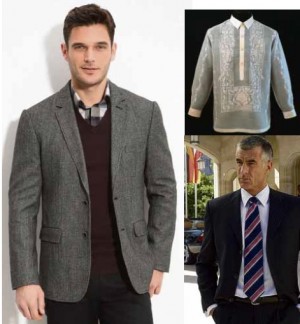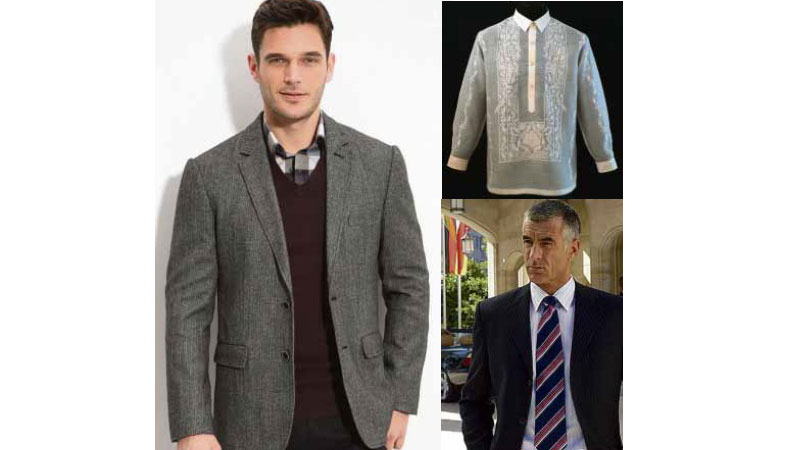
December is the season of celebrations and thanksgiving. There will be office parties, school parties, reunions, weddings, baptisms, anniversaries.
Many men will face the dilemma of how to dress up appropriately for these different occasions. If you wear the wrong attire, you may either be lucky and called a “standout,” or stick out like a sore thumb.
Most men need a guide to dressing up. There are a few style guides out there, like Gentleman’s Quarterly (popularly known as GQ) and a handful of other men’s magazines. But these mags are geared toward promoting known (often pricey) menswear labels and passing trends. Models, fashion designers and male dress horses make full use of the material in these publications.
But there is scarce material for regular guys to use as a standard of what to wear for different occasions.
First, understand that “dressing up” means just that—you dress up to a higher level. The dress code is written in an invitation as the attire that the party’s host wants you to wear. Plenty of work, planning and design are put into setting up the event which follows a specific motif. The dress code ensures that you will fit into the theme of the occasion. It shows that you belong there.
Historically, the purpose of having a dress code was to be able to set classes of people apart. The lower-class citizens could not afford to dress the same way the upper-class folks did. The way people dressed up was a visual clue as to what level they belonged to in society. It was also an effective way of spotting gatecrashers at a party.
The invited male guest shows good social manners by adhering to dressing up according to the dress code. It should be respected and followed by any man who is considerate of his host’s wishes.
The codes are flexible to a certain degree, but the male guest should stay within the range of what is acceptable.
Formal wear
1. Black tie—A tuxedo or a suit generally made of black wool with black satin lapels. It has matching trousers with a black satin stripe running down the exterior of the pants’ leg. Wear it with a black satin bow tie and black cummerbund. Sometimes a vest is worn with it. It is also still referred to as “dinner clothes” or “dinner jacket.”
2. Cummerbund —This is a wide, pleated sash that you wear around your waistband as part of formal wear. It is correctly worn with the pleats facing upward.
3. White tie—This is not the same suit as in a black tie, but composed of a black wool tailcoat and matching trousers, with a satin stripe running down the exterior of the pants’ leg. It is worn with a white bow tie made of satin, linen or cotton. A white vest which matches the tie is worn as well.
Luckily for Filipino men, our barong Tagalog may be acceptable for both black or white tie events.
Festive
1. Semiformal—Traditionally this event asks that you be in a dark suit or barong variants. Many folks mistake this to refer to business casual.
2. Festive informal—Normally this pertained to wearing a suit with a brightly colored (festive!) tie. Nowadays it means not too formal, but not casual.
3. Cocktail—A dark suit or dressy sports coat, or barong variants. It is a dress-up event.
4. Business attire—A suit with tie or barong Tagalog at the higher levels. In the Philippines, the long-sleeved polo shirt and tie with dark trousers or the short-sleeved polo Barong are accepted.
5. Business casual—Sports coat with the option of wearing a tie. Polo barong is safe. Men in business polo shirts usually take off their neckties.
6. Casual chic—A sports coat, jacket or sweater paired with slacks or jeans. Layering seems to be the key.
7. Casual—The most relaxed dress code. You can wear slacks, jeans or shorts with any top you want, depending on your host’s directions.
Clothing options a man can invest in
1. Barong Tagalog— Sometimes referred to as barong Pilipino. This traditional Filipino outfit is an embroidered formal shirt. It is lightweight and worn untucked over an undershirt. It has long sleeves and is made of either pineapple, banana or abaca fibers. Every Filipino should have a good quality barong in his wardrobe. It is very versatile for any dressy event, from the very formal down to business attire. Choose a classic design, and it can be used for decades.
2. Dark suit— If you go to many events, you need to have your own dark suit. It should be cut in a timeless style, in a color like black, navy blue or gray to ensure long use. A dress shirt, along with a coordinated tie, are worn with it. Like the barong, it is safe attire for many events including weddings, birthdays, anniversaries, business meetings, cocktails, funerals.
3. Barong variants:
Gusot-mayaman and linen barong —These are not made of delicate fabrics. They are less formal than the standard barong Tagalog.
Polo barong—A short-sleeved version of the barong, often made of linen, ramie or cotton. This is the least formal version of the Barong and is often used as men’s office wear.
Shirt-jack barong—These are cut in shirt-jack style, usually made of polyester-cotton, linen-cotton and gusot-mayaman fabrics.
All three barong variants are safe to use for different occasions. You get a look that is above casual and at the same time not too dressy. You could pull off wearing them to almost any event. (Just beware that you may be dressed like security personnel.)
The dress code does not refer to style. It defines the rules of what to wear for different events. When a man understands these rules, he will feel confident wearing the right clothes for the right occasion.








































